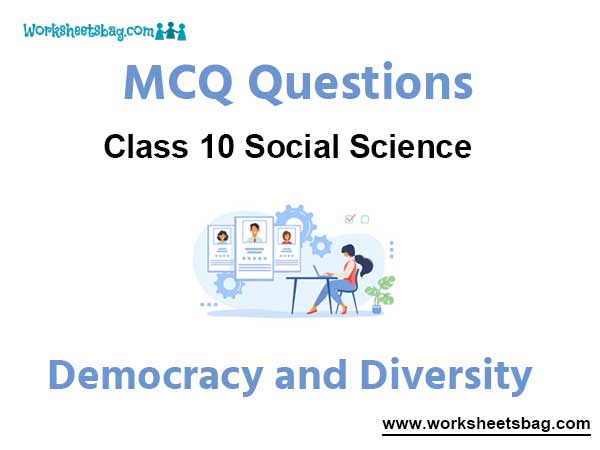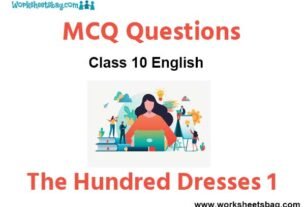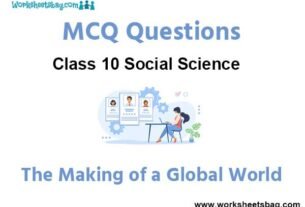Please refer to Democracy and Diversity MCQ Questions Class 10 Social Science below. These MCQ questions for Class 10 Social Science with answers have been designed as per the latest NCERT, CBSE books, and syllabus issued for the current academic year. These objective questions for Democracy and Diversity will help you to prepare for the exams and get more marks.
Democracy and Diversity MCQ Questions Class 10 Social Science
Please see solved MCQ Questions for Democracy and Diversity in Class 10 Social Science. All questions and answers have been prepared by expert faculty of standard 10 based on the latest examination guidelines.
MCQ Questions Class 10 Social Science Democracy and Diversity
Question. The society in which no ethnic differences prevail is
(a) heterogeneous society.
(b) overlapping society.
(c) homogenous society.
(d) semi-hetrogeneous society.
Answer
C
Question. The nation which was highly homogenous was
(a) Germany.
(b) US.
(c) United Kingdom.
(d) Mexico.
Answer
A
Question. Olympics were held in the Mexico City in
(a) 1932.
(b) 1936.
(c) 1964.
(d) 1968.
Answer
D
Question. Which of the following parties represents interests of Catholics in the UK?
(a) Unionist
(b) Nationalist
(c) Socialist
(d) Liberals
Answer
B
Question. The correct percentage of Roman Catholics in Northern Ireland was
(a) 44%
(b) 51%
(c) 56%
(d) 61%
Answer
A
Question. The positive side of social differences is
(a) division on religious lines.
(b) harmony among people of different groups.
(c) differences crosscut each other.
(d) easy demarcation of society.
Answer
B
Question. Which one of the following does not take place when there is social difference in a society or country?
(a) Economic division.
(b) Regional division.
(c) Cultural division.
(d) Social division.
Answer
C
Question. ‘Homogenous society’ stands for:
(a) Society with different kinds of people.
(b) Society with similar kinds of people especially with no significant ethnic differences.
(c) People shift from one country to another country.
(d) Migrants from other countries to a society are called homogenous society.
Answer
B
Question. Along with birth, some of the social differences are based on
(a) abilities.
(b) appearances
(c) disabilities.
(d) choices.
Answer
D
Question. In Mexico Olympics, American athletes were supported by an athlete of
(a) Germany
(b) France
(c) Australia
(d) New Zealand
Answer
C
Question. What is meant by the term migrant?
(a) People who shift from one country to another country for economic opportunities.
(b) People who shifts from one place to another place in the same village.
(c) People who shifts from one society to another society to celebrate festivals.
(d) People who shift from India to U.S.A. are called migrant.
Answer
A
Question. Identify the community which was brought to America during the 17th century
(a) Afro- American
(b) Australian
(c) Mexican
(d) Dalits
Answer
A
Question. The number of factors which are crucial in deciding the outcome of politics of social divisions are
(a) two.
(b) three.
(c) four.
(d) six.
Answer
B
Question. The political reason behind the conflicts in Sri Lanka is
(a) preferential policies of government.
(b) failure of non government organizations.
(c) unwillingness of parties to resolve conflict.
(d) absence of representation for weak.
Answer
A
Question. The act of Tommie Smith and John Carlos was considered by the International Olympic association as a
(a) racial symbol
(b) political statement
(c) religious act
(d) social difference
Answer
B
Question. Identify the reason responsible for the cease-fire among Nationalists and British security forces in Northern Ireland
(a) partition of state
(b) loss of nationalist in war
(c) peace agreement
(d) victory of Labour party in UK’s election
Answer
C
Question. Which one of the following countries does the region of Ireland belong to?
(a) France.
(b) United Kingdom.
(c) United States of America.
(d) Russia.
Answer
B
Question. Social differences can take the form of
(a) economic equality.
(b) social inequality.
(c) political stability.
(d) cultural equality.
Answer
B
Question. The second factor responsible for the outcome of politics of social division is
(a) issue related to national identity.
(b) approach by political parties.
(c) how demands are raised.
(d) response of discriminated group.
Answer
B
Question. The political expression of social division is very healthy for the
(a) Monarchy
(b) Dictatorship
(c) Aristocracy
(d) Democracy
Answer
D
Question. The movement emerged in 1966 and lastes till 1975 to end racism in the US. Identify the movement:
(a) The Black Power Movement
(b) African-American Movement
(c) Civil Rights Movement
(d) Non-Cooperation Movement
Answer
A
Question. Homogeneous Society means
(a) Similar kind of cultural heritage
(b) Exist Caste based differences
(c) Absence of community feeling
(d) Different kinds of living style of people.
Answer
A
Question. The conflicts which were prevatent in the Northern Ireland for a long time were
(a) religious.
(b) militant.
(c) racism.
(d) ethno-political.
Answer
D
Question. Who of the following won gold and bronze medals respectively in 200 meters race in Mexico City Olympics in 1968?
(a) Tomme Smith, John Carlos.
(b) Peter Norman, Jessie Owen.
(c) Carl Lewis, F. Benjamin.
(d) Ben Johnson, Carlos John.
Answer
A
Question. King Martin Luther Jr.was influenced by
(a) John Carlos.
(b) Abraham Lincoln.
(c) Mahatma Gandhi.
(d) Jawaharlal Nehru.
Answer
C
Question. The social difference that is based on the principle of “accident of birth” is
(a) priest or soldier.
(b) male or female.
(c) rich or poor.
(d) atheists or non atheists.
Answer
B
Question. The factor behind the discrimination of dalits in India is
(a) religion.
(b) language.
(c) profession.
(d) class or caste.
Answer
D
Question. The university that had installed a 20-foot high sculpture of Tommie Smith is
(a) Johnson and Wales.
(b) San Jose State.
(c) San Diego Christian.
(d) Tufts University.
Answer
B
Question. Identify the factor responsible for the migration
(a) political
(b) economic
(c) social
(d) cultural
Answer
B
Question. The first factor crucial in deciding the outcome of politics of social division is
(a) peaceful thoughts
(b) policies of parties
(c) decisions of leaders
(d) how people perceive their identities.
Answer
D
Question. The third factor responsible for the outcome of politics of social division is
(a) role of movements.
(b) positive attitude of government.
(c) political support.
(d) legal laws.
Answer
B
Question. An example of crosscutting differences is
(a) religion.
(b) caste.
(c) political conditions.
(d) views.
Answer
D
FILL IN THE BLANKS
Question. __________ is a person who does not believe in God or religion.
Answer
CAtheist
Question. In 1968 the Olympics were held in __________ .
Answer
Merico city
Question. Most of the social differences are based on __________.
Answer
Birth
Question. __________ started the civil rights movements in USA.
Answer
Martin Luther King Jr.
Question. A society which has similar kinds of people is known as __________.
Answer
Homogeneous
TRUE / FALSE
Question. ‘Civil Rights Movement’ took place in U.S. during 1954-68.
Answer
True
Question. Tommie & John received the medals in 200 mt race.
Answer
True
Question. Yugoslavia was disintegrated into independent countries in 1996.
Answer
True
Question. Peter norman was an African-American athlete.
Answer
False
Question. A peaceful treaty was signed between the U.K. government and the Nationalists in 1996.
Answer
False
Match the following
Question.
| Column-A | Column-B |
| 1. The 1968 Olympics was held | (a) 2006 |
| 2. Norman died in | (b) 1998 |
| 3. Dalits | (c) African-Americans |
| 4. A peace treaty was signed by UK government and Nationals | (d) poor and landless |
| 5. Carlos and Smith | (e) in Mexico city |
Answer :
| Column-A | Column-B |
| 1. The 1968 Olympics was held | (e) in Mexico city |
| 2. Norman died in | (a) 2006 |
| 3. Dalits | (d) poor and landless |
| 4. A peace treaty was signed by UK government and Nationals | (b) 1998 |
| 5. Carlos and Smith | (c) African-Americans |
Question.
| Column-I | Column-II | Column-III |
| 1. Social differences are mostly | (a) to social | A. accident by birth |
| 2. Every social division does not lead | (b) on our | B. in most countries |
| 3. Some of the social differences are based | (c) are easier | C. choices |
| 4. Cross-cutting social differences | (d) based on | D. division |
| 5. Social division of one kind or another | (e) exist | E. to accommodate |
Answer :
| Column-I | Column-II | Column-III |
| 1. Social differences are mostly | (d) based on | A. accident by birth |
| 2. Every social division does not lead | (a) to social | D. division |
| 3. Some of the social differences are based | (b) on our | C. choices |
| 4. Cross-cutting social differences | (c) are easier | E. to accommodate |
| 5. Social division of one kind or another | (e) exist | B. in most countries |
Question.
| Column-A | Column-B |
| 1. African-American | (a) A militant anti-racist-movement in US. |
| 2. Black Power | (b) A society that has similar kinds of people. |
| 3. Migrant | (c) A set of reforms movement aimed at abolishing legal racial discrimination. |
| 4. Homogenous society | (d) Anybody who shifts from one region to another region. |
| 5. Civil Rights Movement | (e) Black American. |
Answer :
| Column-A | Column-B |
| 1. African-American | (e) Black American. |
| 2. Black Power | (a) A militant anti-racist-movement in US. |
| 3. Migrant | (d) Anybody who shifts from one region to another region. |
| 4. Homogenous society | (b) A society that has similar kinds of people. |
| 5. Civil Rights Movement | (c) A set of reforms movement aimed at abolishing legal racial discrimination. |
Match the following :
| Column A | Column B |
| 1. Civil Rights | (A) Society with similar Kind of people. |
| 2. Black power | (B) won gold and bronze medal |
| 3. Tommie Smith and John Carles | (C) It was a militant and racial movement |
| 4. Homogeneous society | (D) Initiated by Martin Luther King Junior |
Answer
1. (D), 2. (C), 3. (B), 4. (A)



